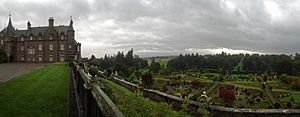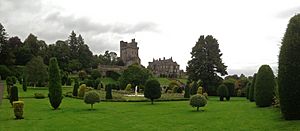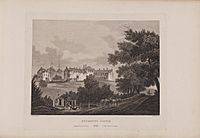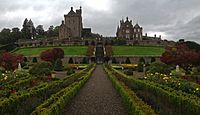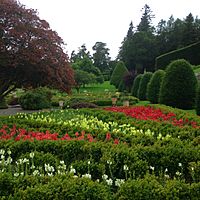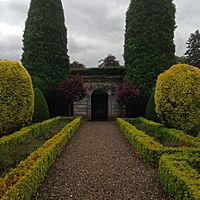Drummond Castle facts for kids
Drummond Castle is a famous castle located in Perthshire, Scotland. It is especially well-known for its amazing gardens. These gardens are so special that Historic Environment Scotland calls them "the best example of formal terraced gardens in Scotland."
The castle is found near Muthill parish, about 4 kilometers (2.5 miles) south of Crieff. It includes an old tower house built in the late 1400s. There's also a larger mansion from the 1600s. Both parts were updated in Victorian times. The beautiful gardens were first created in the 1630s. They were also redesigned in the 1800s.
The formal gardens are very important. They are protected as a special historic site. The tower house and mansion are also protected buildings.
Contents
History of Drummond Castle
The Drummond family has owned the land where the castle stands since the 1300s. The first tower house was started around 1490 by John Drummond, who became the 1st Lord Drummond of Cargill.
In 1605, the 4th Lord Drummond was given the title of Earl of Perth. He added more to the castle. The 2nd Earl of Perth began creating the first terraced garden around the castle in the 1630s.
The castle faced tough times. In 1653, during a period of conflict in Scotland, the army of Oliver Cromwell attacked the castle. Later, the 4th Earl of Perth was a high-ranking official for King James VII. He started building the mansion house in 1689. However, he was later put in prison when King James was removed from power. He then went to France.
The Drummond family continued to support King James and his followers. They were involved in the Jacobite uprisings of 1715 and 1745. Because of this, the family lost control of the estate in 1750. The government managed it until 1784. Then, it was sold to Captain James Drummond.
Captain Drummond started making improvements to the castle and gardens. His daughter, Sarah, and her husband, The 22nd Baron Willoughby de Eresby, continued this work. They created the formal gardens and terraces in the 1830s. Queen Victoria herself visited these gardens in 1842!
Drummond Castle later passed to Clementina Drummond-Willoughby. Then it went to her son, The 1st Earl of Ancaster. The top parts of the tower house were rebuilt in an old-fashioned castle style between 1842 and 1853. The mansion was also updated in 1878.
In the 1950s, the 3rd Earl of Ancaster and his wife, Nancy Astor, replanted the gardens. Today, the castle is owned by Jane Heathcote-Drummond-Willoughby, 28th Baroness Willoughby de Eresby. She inherited it from her father. The castle itself is not open to visitors, but the beautiful gardens are managed by a trust.
What Drummond Castle Looks Like
The castle sits on a high, rocky ridge called the Gask Ridge. This ridge stretches for several kilometers across Perthshire. It is very noticeable and steep at the castle's location.
The old tower house, or keep, is no longer used as a home. Next to it is a well-preserved gatehouse, built between 1629 and 1630. This gatehouse was made to control who could enter the courtyard behind it. From the courtyard, you get a fantastic view over the formal gardens. The beautiful gardens are located to the south of the castle, on its rocky perch.
You might have seen Drummond Castle before! The castle buildings and gardens were used as filming locations in the 1995 movie Rob Roy.
The Amazing Gardens
The gardens at Drummond Castle might have been around since the late 1400s. A big change to both the gardens and castle happened between 1630 and 1636. The way the gardens look now started in the 1830s. This was based on a design by Lewis Kennedy. This redesign happened after Clementina Drummond and her husband inherited the estate.
As mentioned, Queen Victoria and Prince Albert visited the garden in 1842.
The garden was originally very large, about 12 acres. It was made a bit smaller after World War II. The main part of the garden has a special design. It shows the Drummond family's symbol, with Scottish thistles and daggers. Its paths form an 'X' shape, leading to an old stone sundial from 1630.
Fans of the TV show Outlander (TV series) might recognize the gardens. They were used to represent the formal garden at the Palace of Versailles in France, as it might have looked during the time of King Louis XV.
According to Visit Scotland, "Drummond Gardens are some of Scotland’s most important formal gardens." They are also considered "among the finest in Europe." The gardens were redesigned and terraced in the 1800s. The gardens you see today were replanted in the 1950s. Due to the worldwide pandemic, the gardens were closed to visitors for a time in recent years.
Gallery
- Drummond castle & gardens
Images for kids
See also
 In Spanish: Castillo de Drummond para niños
In Spanish: Castillo de Drummond para niños


